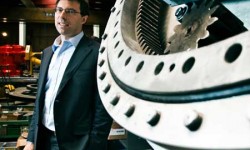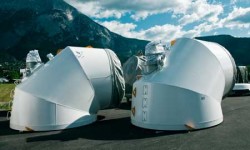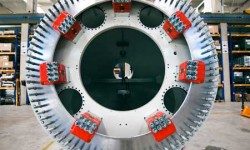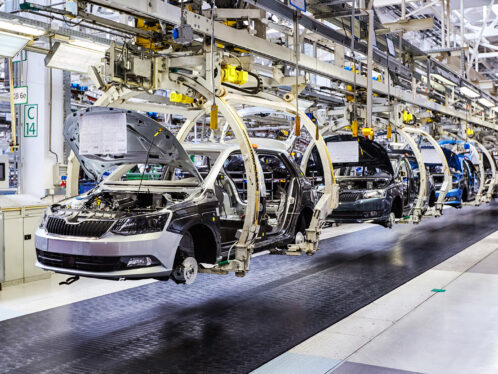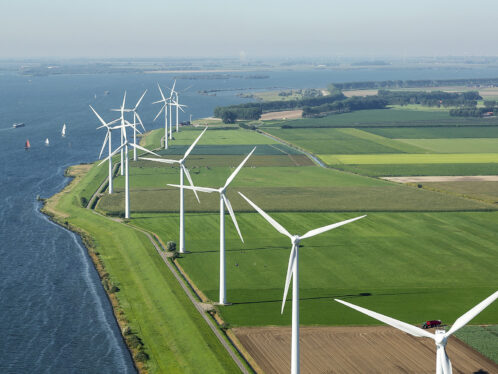
Smart solutions for windy conditions
Wind turbines are reaching new heights. A young wind energy company, Leitwind, is providing solutions to make these heights possible.
Facts
Leitner Technologies is a privately owned company that was founded in 1888 by Gabriel Leitner in Sterzing, in Bolzano, Italy. Leitner Technologies has plants in Italy, Austria, France, India and North America, as well as 70 sales and service points worldwide. The turnover in 2008 was 540 million euros and the number of employees was 2,030.
In 2000, Leitner launched the Leitwind wind turbine operation, and Leitwind became an independent company (but still a unit of Leitner Technologies) in August 2008.
The production of wind turbines is concentrated in Telfs, Austria, and Chennai, India.
At present, Leitwind produces two types of wind turbines, the LTW70 and the LTW77, each producing 1.5 MW of power. A 3 MW wind turbine is in development. The company estimates sales of 60 turbines in 2009.
(www.leitwind.com) (www.leitner-technologies.com)
Wind turbines are reaching new heights. A young wind energy company, Leitwind, is providing solutions to make these heights possible.
Some first-time visitors to the ski slopes of Salzstiegl, Austria, are surprised to see a 65-metre-high wind turbine flanking one of the resort’s runs. They might be even more surprised to learn that this single turbine supplies all the power needed to operate the resort’s ski lifts and ropeways. In addition, it supplies power to a local hotel and various mountain chalets and contributes to the community power grid. Moreover, at 1,750 metres altitude, it is the fourth-highest megawatt-class wind turbine installation in the world and had to be designed to overcome the problem of ice formation.
Visitors to Uthumalai, a city in southern India, may see a similar turbine in their midst, in spite of the climatic differences: temperatures of 50 degrees Celsius, high humidity, unstable grids and seasonal monsoons. The structure and equipment had to be designed to meet all these challenges as well as the danger of poisonous snakes in the switch cabinets.
Behind the solutions that made these wind turbines possible is a young wind energy company called Leitwind, an affiliate of Leitner Technologies of Italy. Although Leitwind is a new entry in the wind turbine market, its parent company has been solving engin-eering problems since 1888. Leitner Technologies is one of the world’s leaders in ropeway systems and ski infrastructure (chairlifts, gondolas and funiculars), a market sector it entered after World War II. Its admirable safety record is part of its success story.
But the ski industry is a maturing one. “A company must innovate constantly if it wants to grow and survive,” observes Anton Seeber, CEO of Leitwind and son of Michael Seeber, CEO and chairman of Leitner Technologies. Renewable energy is still in its early stages, so it was attractive to Leitner, which prides itself on solving problems through innovation. In 2008, the company spent more than 16 million euros on R&D, an increase of almost 25 percent over 2007 expenditures.
Leitner began evaluating the wind turbine industry almost a decade ago. Although this industry had established players, including some multinational giants, the company believed it had a leading edge in several areas. It had a proven team of electro-mechan-ical engineers, and it possessed the know-how to build direct-drive generators, eliminating the need for the heavy gearboxes used in most wind turbines. And because of its expertise with ski installations, it was used to installing equipment in demanding environments and dealing with natural elements, including the winds in mountainous areas.
Leitner launched Leitwind in 2000, and Leitwind started planning and building its first 1.2 megawatt prototype in 2001. Following four years of testing, the company built a second 1.5 MW prototype in 2005. Sales began in 2007, when the company was confident about its product. The turbines in both Salzstiegl and Uthumalai were installed that year.
“We focused on simplicity and quality,” says Seeber. “We designed our turbines to last at least 25 years, and because of our background and the emphasis on quality and safety, we over-designed to eliminate risk. This made SKF a natural partner for us since SKF supplies products of the highest quality.”
SKF also had partneredwith Leitner for years in the manufacture of ropeways, snow groomers and, more recently, urban transport systems.
In 2008, Leitwind’s second year of commercial activity, it sold 12 turbines, including turbines for the first MW-class wind energy project installed in Bulgaria. In November 2008, it opened a new production facility in Telfs, Austria, including in-house testing equipment for its turbines. Leitwind is expecting to install 60 turbines worldwide in 2009 and anticipates that unit sales will increase in 2010, thanks in part to its joint ventures in India with Shriram EPC, including a greenfield manu-facturing facility near Chennai. “We are very positive about this market,” says Seeber. “We expect 60 to 70 percent of our production there to be sold locally.”
The Chennai plant, like its counterpart in Telfs, is producing 1.5 MW turbines, for which all main components are built in-house except for the blades and bearings. Although not the most powerful turbine on the market, the 1.5 MW model is well suited to the geographic areas that have been Leitwind’s primary focus and is more efficient and easier to install than some larger competitors’ turbines.
In addition, Leitwind is developing a 3 MW turbine with support from SKF that will extend the product range. “We are completely verticalized,” says Seeber. “But we still consider ourselves a start-up. We want to avoid being ‘windy’; we are always thinking long term.”
SUCCESS THROUGH SIMPLICITY
“A wind turbine is basically a simple concept,” notes Anton Seeber, CEO and chairman of the board of Leitwind. “You need simple solutions at high altitudes because the cost of doing repairs is prohibitive. We are used to this because our ropeways can’t fail or stop working, and they have to function in very harsh conditions.”
Leitwind turbines boast:
• A gearless direct drive, for greater efficiency and lower maintenance costs. This means that Leitwind’s turbines are more efficient at low wind speeds, where a smaller-diameter rotor can produce more energy than a larger rotor, since less wind power is needed to spin the smaller generator.
• A synchronous generator with permanent magnets for maximized power yield and economies of installation.
• A proprietary frequency converter that provides a high degree of grid compatibility and smooth operation even within weak and unstable grids.
• A modular design for lower transport and installation costs and easier maintenance. For example, the nacelle is designed with a doorway so that parts can be removed and lowered to the ground, reducing time and manpower costs.
A MULTI-PLATFORM SOLUTION
Bearings are critical to the operation of a wind turbine, both on the main shaft and in the hub, to manage pitch (position of the three blades) and yaw (position of the nacelle around its vertical axis). They are the costliest components of a wind turbine, and there are no standard solutions: Each bearing is chosen after calculation of projected power density (the relation between weight and energy output).
As described by account manager Stefano Tenuti and application engineer Simona Allio, SKF Industrial Division Sales Europe, SKF supplies a multi-platform solution to Leitwind as follows:
• A special double-row tapered roller bearing for the main shaft
• Slewing bearings for the pitch application
• A slewing bearing for the yaw application
• A lubrication system (SKF Lubrication Systems) to provide excellent working conditions for the bearings
• SKF Engineering Consultancy Services support for technical verification of the complete drivetrain system
• SKF Reliability Systems support for vibration analysis, mounting and dismounting
• Customized seals for the main bearing, including technical and commercial evaluation.


